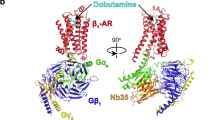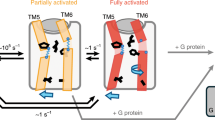Abstract
G protein–coupled receptors (GPCRs) recognize a wide variety of extracellular ligands to control diverse physiological processes. Compounds that bind to such receptors can either stimulate, fully or partially (full or partial agonists), or reduce (inverse agonists) the receptors' basal activity and receptor-mediated signaling. Various studies have shown that the activation of receptors through binding of agonists proceeds by conformational changes as the receptor switches from a resting to an active state leading to G protein signaling1,2,3,4,5. Yet the molecular basis for differences between agonists and inverse agonists is unclear. These different classes of compounds are assumed to switch the receptors' conformation in distinct ways. It is not known, however, whether such switching occurs along a linear 'on-off' scale or whether agonists and inverse agonists induce different switch mechanisms. Using a fluorescence-based approach to study the α2A-adrenergic receptor (α2AAR), we show that inverse agonists are differentiated from agonists in that they trigger a very distinct mode of a receptor's switch. This switch couples inverse agonist binding to the suppression of activity in the receptor.
This is a preview of subscription content, access via your institution
Access options
Subscribe to this journal
Receive 12 print issues and online access
$259.00 per year
only $21.58 per issue
Buy this article
- Purchase on Springer Link
- Instant access to full article PDF
Prices may be subject to local taxes which are calculated during checkout



Similar content being viewed by others
References
Gether, U., Lin, S.B. & Kobilka, B.K. Fluorescent labeling of purified β2 adrenergic receptor. J. Biol. Chem. 270, 28268–28275 (1995).
Ghanouni, P., Steenhuis, J., Farrens, D.L. & Kobilka, B.K. Agonist-induced conformational changes in the G-protein–coupling domain of the β2 adrenergic receptor. Proc. Natl. Acad. Sci. USA 98, 5997–6002 (2001).
Ghanouni, P. et al. Functionally different agonists induce distinct conformations in the G protein coupling domain of the β2 adrenergic receptor. J. Biol. Chem. 276, 24433–24436 (2001).
Sheikh, S.P. et al. Similar structures and shared switch mechanisms of the β2-adrenoceptor and the parathyroid hormone receptor. J. Biol. Chem. 274, 17033–17041 (1999).
Vilardaga, J.-P., Bünemann, M., Krasel, C., Castro, M. & Lohse, M. Measurement of the millisecond activation switch of G protein–coupled receptors in living cells. Nat. Biotechnol. 21, 807–812 (2003).
De Ligt, R.A.F., Kourounakis, A.P. & Ijzerman, A.P. Inverse agonism at G protein–coupled receptors: (patho)physiological relevance and implications for drug discovery. Br. J. Pharmacol. 130, 1–12 (2003).
Strange, P.G. Mechanisms of inverse agonism at G protein–coupled receptors. Trends Pharmacol. Sci. 23, 89–95 (2002).
Kenakin, T. Efficacy as a vector: the relative prevalence and paucity of inverse agonism. Mol. Pharmacol. 65, 2–11 (2004).
Wade, S.M., Lan, K.-L., Moore, D.J. & Neubig, R.R. Inverse agonist activity at the α2A-adrenergic receptor. Mol. Pharmacol. 59, 532–542 (2001).
Cognet, L., Harms, G.S., Blab, G.A., Lommerse, P.H.M. & Schmidt, T. Simultaneous dual-colors and dual-polarization imaging of single molecules. Appl. Phys. Lett. 77, 4052–4054 (2000).
Rizzo, M.A., Springer, G.H., Granada, B. & Piston, D.W. An improved cyan fluorescent protein variant useful for FRET. Nat. Biotechnol. 22, 445–449 (2004).
Heikal, A.A., Hess, S.T., Baird, G.S., Tsien, R.Y. & Webb, W.W. Molecular spectroscopy and dynamics of intrinsically fluorescent protein: coral red (dsRed) and yellow (citrine). Proc. Natl. Acad. Sci. USA 97, 11996–12001 (2000).
Ren, Q., Kurose, H., Lefkowitz, R.J. & Cotecchia, S. Constitutive active mutants of the α2-adrenergic receptor. J. Biol. Chem. 268, 16483–16487 (1993).
Vilardaga, J.-P., Di Paolo, E. & Bollen, A. Improved PCR method for high efficacy site-directed mutagenesis using class 2S restriction enzymes. Biotechniques 18, 605–606 (1995).
Bünemann, M., Bücheler, M.M., Philipp, M., Lohse, M. & Hein, L. Activation and deactivation kinetics of α2A- and α2C-adrenergic receptor–activated G protein–activated inwardly rectifying K+ channel currents. J. Biol. Chem. 276, 47512–47517 (2001).
Vilardaga, J.-P., Lin, I. & Nissenson, R.A. Analysis of parathyroid hormone (PTH)/secretin receptors chimeras differentiates the role of functional domains in the PTH/PTH-related peptide receptor on hormone binding and receptor activation. Mol. Endocrinol. 15, 1186–1199 (2001).
Acknowledgements
We thank M. Bernhard for technical support and K.-N. Klotz and M. Bünemann for comments. The Deutsche Forschungsgemeinschaft and the Fonds der Chemischen Industrie supported this work.
Author information
Authors and Affiliations
Corresponding author
Ethics declarations
Competing interests
The authors declare no competing financial interests.
Supplementary information
Supplementary Fig. 1
Principle of the experiment. (GIF 16 kb)
Supplementary Fig. 2
Chemical structures and names of the diverse ligands used in this study. (GIF 19 kb)
Supplementary Fig. 3
Optical recording of different receptor states from a single cell expressing α2AARCFP/YFP. (GIF 12 kb)
Supplementary Fig. 4
Characterization of the constitutively active α2A-adrenergic receptors. (GIF 29 kb)
Rights and permissions
About this article
Cite this article
Vilardaga, JP., Steinmeyer, R., Harms, G. et al. Molecular basis of inverse agonism in a G protein–coupled receptor. Nat Chem Biol 1, 25–28 (2005). https://doi.org/10.1038/nchembio705
Received:
Accepted:
Published:
Issue Date:
DOI: https://doi.org/10.1038/nchembio705
This article is cited by
-
Conformational signatures in β-arrestin2 reveal natural biased agonism at a G-protein-coupled receptor
Communications Biology (2018)
-
HTS-compatible FRET-based conformational sensors clarify membrane receptor activation
Nature Chemical Biology (2017)
-
ER/K linked GPCR-G protein fusions systematically modulate second messenger response in cells
Scientific Reports (2017)
-
Endosomal generation of cAMP in GPCR signaling
Nature Chemical Biology (2014)
-
Signalling bias in new drug discovery: detection, quantification and therapeutic impact
Nature Reviews Drug Discovery (2013)



